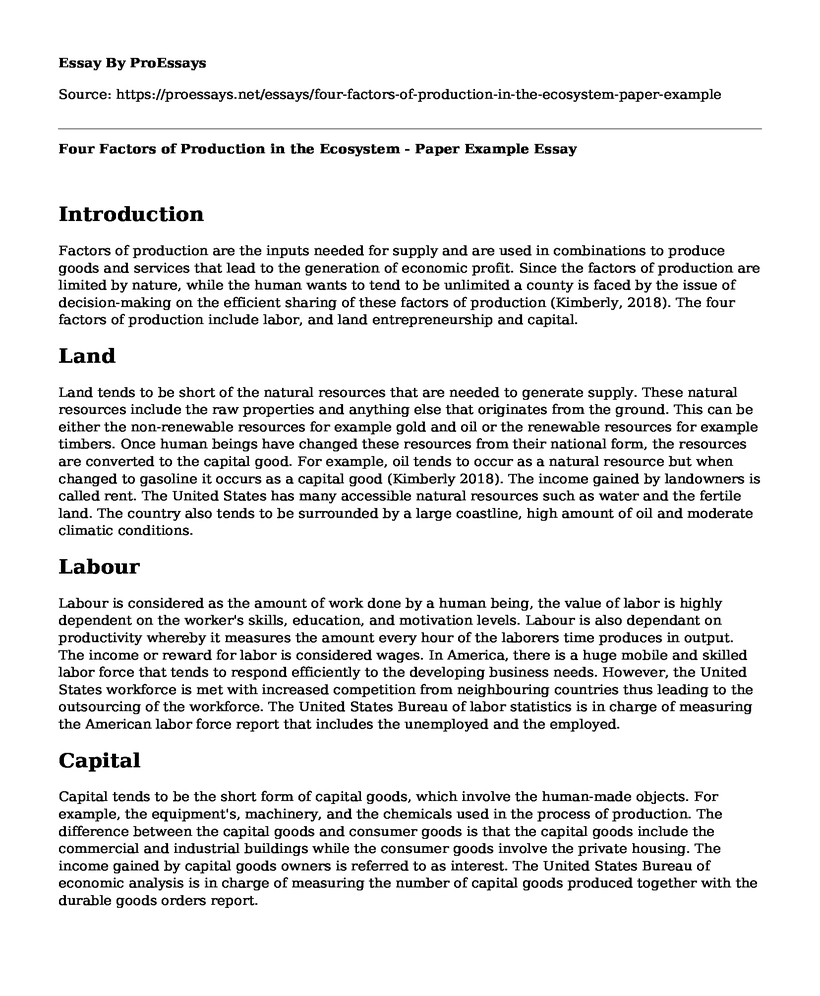Introduction
Factors of production are the inputs needed for supply and are used in combinations to produce goods and services that lead to the generation of economic profit. Since the factors of production are limited by nature, while the human wants to tend to be unlimited a county is faced by the issue of decision-making on the efficient sharing of these factors of production (Kimberly, 2018). The four factors of production include labor, and land entrepreneurship and capital.
Land
Land tends to be short of the natural resources that are needed to generate supply. These natural resources include the raw properties and anything else that originates from the ground. This can be either the non-renewable resources for example gold and oil or the renewable resources for example timbers. Once human beings have changed these resources from their national form, the resources are converted to the capital good. For example, oil tends to occur as a natural resource but when changed to gasoline it occurs as a capital good (Kimberly 2018). The income gained by landowners is called rent. The United States has many accessible natural resources such as water and the fertile land. The country also tends to be surrounded by a large coastline, high amount of oil and moderate climatic conditions.
Labour
Labour is considered as the amount of work done by a human being, the value of labor is highly dependent on the worker's skills, education, and motivation levels. Labour is also dependant on productivity whereby it measures the amount every hour of the laborers time produces in output. The income or reward for labor is considered wages. In America, there is a huge mobile and skilled labor force that tends to respond efficiently to the developing business needs. However, the United States workforce is met with increased competition from neighbouring countries thus leading to the outsourcing of the workforce. The United States Bureau of labor statistics is in charge of measuring the American labor force report that includes the unemployed and the employed.
Capital
Capital tends to be the short form of capital goods, which involve the human-made objects. For example, the equipment's, machinery, and the chemicals used in the process of production. The difference between the capital goods and consumer goods is that the capital goods include the commercial and industrial buildings while the consumer goods involve the private housing. The income gained by capital goods owners is referred to as interest. The United States Bureau of economic analysis is in charge of measuring the number of capital goods produced together with the durable goods orders report.
Entrepreneurship
Entrepreneurship is considered as the motivation to initiate a certain idea into the business. Entrepreneurs join the other factors of production that island, capital, and labor to improve on supply. The entrepreneurs tend to earn their income through profits. Most of the United States entrepreneurs own the small business that is the 5.8 million companies out of the 6 million companies thus creating 65% of the overall new jobs in the market (Kimberly, 2018).
Reference
Kimberly Amadeo, (2018).Factors of Production, the Four Types, and Who Owns Them.
Cite this page
Four Factors of Production in the Ecosystem - Paper Example. (2022, Jul 11). Retrieved from https://proessays.net/essays/four-factors-of-production-in-the-ecosystem-paper-example
If you are the original author of this essay and no longer wish to have it published on the ProEssays website, please click below to request its removal:
- Essay on Management: Leadership and Management in Professional Contexts
- BNP Paribas, Culture Shock and Humanized Robots Reports
- Catching the Interests of Physician Leadership Essay Example
- Essay Sample on Global Workforce: The Impact of Leadership on Performance
- Essay Example on IT Governance: A Necessity for Effective Business Strategies
- Leading the Fight: The Role of Noncommissioned Officers in Military Leadership - Essay Sample
- Paper Example on CVS Health & Walgreens: Perfect Examples of Organizational Structure & Culture







